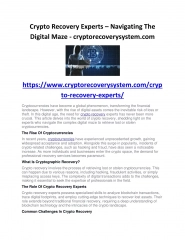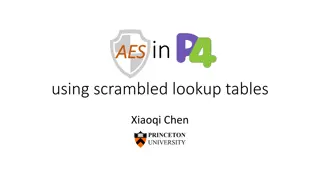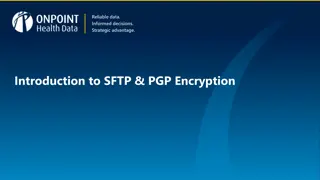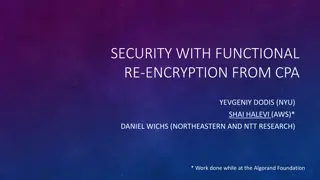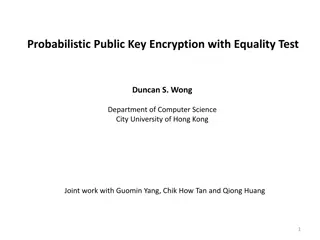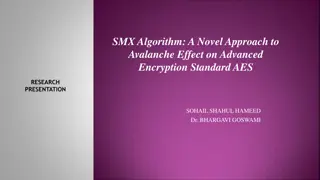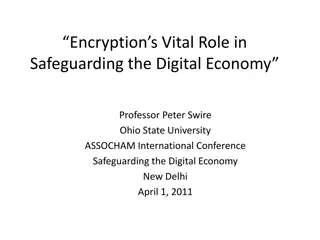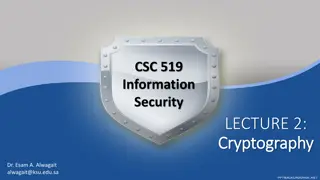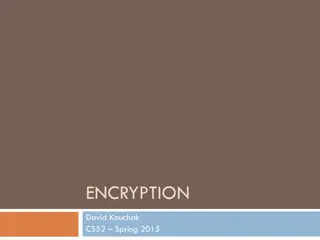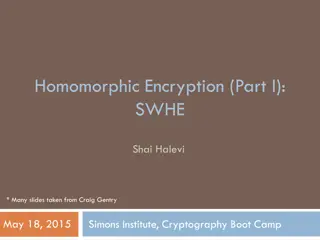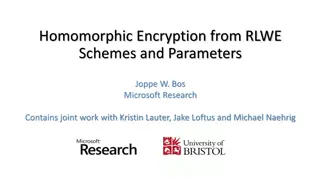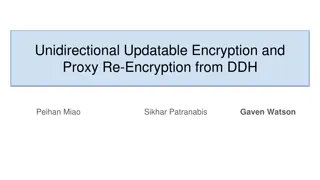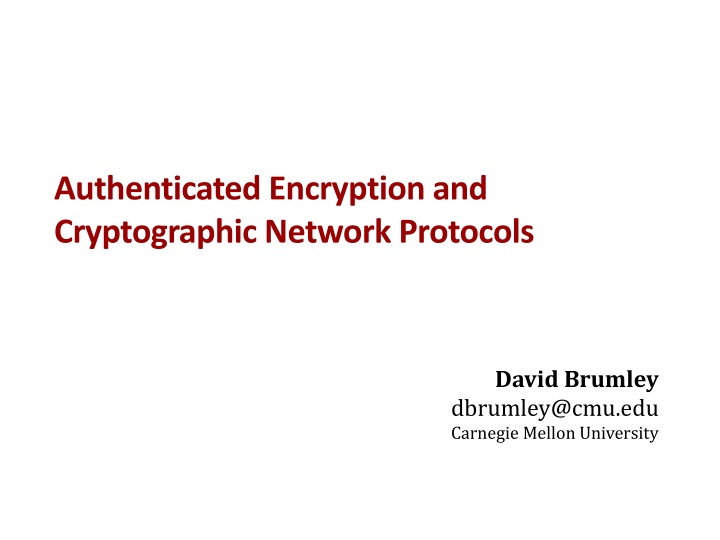
Authenticated Encryption and Cryptographic Protocols
Delve into the world of authenticated encryption, cryptographic network protocols, and security vulnerabilities such as tampering attacks. Learn about encryption methods like CBC with random IV, examples of attacks, and the importance of integrity and confidentiality in cybersecurity.
Download Presentation

Please find below an Image/Link to download the presentation.
The content on the website is provided AS IS for your information and personal use only. It may not be sold, licensed, or shared on other websites without obtaining consent from the author. If you encounter any issues during the download, it is possible that the publisher has removed the file from their server.
You are allowed to download the files provided on this website for personal or commercial use, subject to the condition that they are used lawfully. All files are the property of their respective owners.
The content on the website is provided AS IS for your information and personal use only. It may not be sold, licensed, or shared on other websites without obtaining consent from the author.
E N D
Presentation Transcript
Authenticated Encryption and Cryptographic Network Protocols David Brumley dbrumley@cmu.edu Carnegie Mellon University
TCP/IP (highly abstracted) Webserver (port = 80) packet dest=80 data Source Bob (port = 25) TCP/IP Stack Destination Machine 3
Encrypted with CBC and random IV Webserver (port = 80) encrypted packets with key k k IV1, dest=80 msg a Source Bob IV2, dest=25 msg b (port = 25) k Destination Machine 4
Example Tampering Attack Encrypted with CBC and random IV Webserver (port = 80) encrypted packets with key k k IV1, dest=80 msg a Source Eve IV2, dest=25 msg a (port = 25) k Eve can change destination (easy with CBC and rand IV) Destination Machine 5
Example Tampering Attack Encrypted with CBC and random IV Webserver (port = 80) encrypted packets with key k k IV1, dest=80 msg a Source Eve IV2, dest=1026 msg a (port = 25) k Eve can change destination (easy with CBC and rand IV) Destination Machine 6
How? CBC encryption: D(k, c[0]) IV1= dest=80 IV1, dest=80 msg a Attack: IV2 = IV1 000...80 000...1026 IV2, dest=1026 msg a Eve xor out 80 and xor in 1026 7
An Attack Using Only Network Access Example: Remote terminal app where each keystroke encrypted with CTR mode 16 bit checksum keystroke Alice IP Hdr TCP Hdr c d Bob ack if valid checksum, else nothing Answer: Homework Problem 8
The Story So Far Confidentiality: semantic security against a CPA attack Examples: Using CBC with a PRP, AES Integrity: security against existential forgery Examples: CBC-MAC, NMAC, PMAC, HMAC Now: security against tampering Integrity + Confidentiality! 9
The lesson CPA security cannot guarantee security under active attacks. Secure MAC Integrity Only Secure MAC + Secure Cipher Authenticated Encryption Integrity + Secrecy Integrity + Secrecy 10
Motivating Question: Which is Best? Encryption Key = kE; MAC key = kI Option 1: SSL (MAC-then-encrypt) E(kE , m||tag) m S(kI, m) tag m m tag Option 2: IPsec (Encrypt-then-MAC) E(kE, m) m S(kI , c) tag m m Option 3: SSH (Encrypt-and-MAC) E(kE, m) m S(kI , m) tag m m 11
An authenticated encryptionsystem (E,D) is a cipher where As usual: E: K M N C but D: K C N M { } reject ciphertext as invalid Security: the system must provide Semantic security under CPA attack, and ciphertext integrity. The attacker cannot create a new ciphertext that decrypts properly. 13
Ciphertext Integrity For b ={0,1}, define EXP(0) and EXP(1) as: m1 M m2, , mq Chal. k K Adv A. c2, , cq c1 E(k,m1) c b b=1 if D(k,c) and c { c1, , cq } b=0 otherwise Def: (E,D) has ciphertext integrityiff for all efficient A: AdvCI[A,I] = Pr[Chal. outputs 1] < 14
Authenticated Encryption Def: cipher (E,D) provides authenticated encryption (AE)if it is (1) semantically secure under CPA, and (2) has ciphertext integrity Counter-example: CBC with rand. IV does not provide AE D(k, ) never outputs , hence adv. always wins ciphertext integrity game 15
Implication 1: Authenticity Attacker cannot fool Bob into thinking a message was sent from Alice m1 , , mq c Eve Alice Bob ci = E(k, mi) k k Cannot create valid c { c1, , cq } if D(k,c) Bob guaranteed message is from someone who knows k (but could be a replay) 16
Implication 2 Authenticated encryption Security against chosen ciphertext attack 17
Chosen Ciphertext Attacks Def: A CCA adversary has the capability to get ciphertexts of their choosing decrypted. k k c = E(k,m) m Alice Bob VPN m c Don t want them to learn m ... or even just whether an ACK occurred. Eve sees c and m Eve 19
The Lunchtime CCA Attack It s Lunchtime! Alice s Computer Encrypted File 1 Encryption Program Encrypted File 2 k 20
The Lunchtime CCA Attack Alice s Computer Eve s Encrypted File 1 Eve s Encrypted File 2 Encrypted File 1 Encryption Program Eve Encrypted File 2 k 21
802.11b WEP: how not to do it m CRC(m) k k PRG( IV || k ) ciphertext IV Answer: Homework 22
Chosen Ciphertext Security Adversaries Power: both CPA and CCA Can obtain the encryption of arbitrary messages Can decrypt ciphertexts of his choice Adversaries Goal: break semantic security 23
CCA Game Definition Let ENC = (E,D) over (K,M,C). For b = {0,1}, define EXP(0) and EXP(1) for i=1, ,q: (1) CPA query: Chal. k K Adv. b mi,0 , mi,1 M : |mi,0| = |mi,1| Ex: could query a changed ci ci E(k, mi,b) (2) CCA query: ci C : ci {c1, , ci-1} b {0,1} mi D(k, ci) 24
CCA Game Definition Let ENC = (E,D) over (K,M,C). For b = {0,1}, define EXP(0) and EXP(1) for i=1, ,q: (1) CPA query: b mi,0 , mi,1 M : |mi,0| = |mi,1| ENC = (E,D) is CCA secure iff the Adversary does not do statistically better than guessing. ci E(k, mi,b) Chal. k K Adv. (2) CCA query: ci C : ci {c1, , ci-1} b {0,1} mi D(k, ci) 25
Example: CBC is not CCA Secure m0 , m1 : |m0| = |m1|=1 Chal. k K Adv. c E(k, mb) = (IV, c[0]) b c = (IV 1, c[0]) b learns b D(k,c ) = mb 1 26
Thm: Let (E,D) be a cipher that provides AE. Then (E,D) is CCA secure . AE implies CCA security! 27
So What? Authenticated encryption assures security against: A passive adversary (CPA security) An active adversary that can even decrypt some ciphertexts (CCA security) Limitations: Does not protect against replay Assumes no other information other than message/ciphertext pairs can be learned. Timing attacks out of scope Power attacks out of scope ... 28
AE Constructions Cipher + MAC = security 29
History Pre 2000:Crypto API s provide separate MAC and encrypt primitives Example: Microsoft Cryptographic Application Programming Interface (MS-CAPI) provided HMAC and CBC + IV Every project had to combine primitives in their own way 2000: Authenticated Encryption Bellare and Namprempre in Crypto, 2000 Katz and Yung in FSE, 2000 30
Motivating Question: Which is Best? Encryption Key = kE; MAC key = kI Option 1: SSL (MAC-then-encrypt) E(kE , m||tag) m S(kI, m) tag m m tag Option 2: IPsec (Encrypt-then-MAC) Always Correct E(kE, m) m S(kI , c) tag m m Option 3: SSH (Encrypt-and-MAC) E(kE, m) m S(kI , m) tag m m 31
Theorems Let (E,D) by a CPA secure cipher and (S,V) a MAC secure against existential forgery. Then: 1. Encrypt-then-MAC always provides authenticated encryption 2. MAC-then-encrypt may be insecure against CCA attacks however, when (E,D) is rand-CTR mode or rand- CBC, MAC-then-encrypt provides authenticated encryption 32
Standards GCM: CCM: EAX: CTR mode encryption then CW-MAC CBC-MAC then CTR mode (802.11i) CTR mode encryption then CMAC All are nonce-based. All support Authenticated Encryption with Associated Data (AEAD). Associated Data Encrypted Data Authenticated 33
An example API (OpenSSL) int AES_GCM_Init(AES_GCM_CTX *ain, unsigned char *nonce, unsigned long noncelen, unsigned char *key, unsigned int klen ) int AES_GCM_EncryptUpdate(AES_GCM_CTX *a, unsigned char *aad, unsigned long aadlen, unsigned char *data, unsigned long datalen, unsigned char *out, unsigned long *outlen) 34
MAC Security -- an explanation Recall: MAC security required an attacker given (m , t) couldn t find a different t such that (m,t ) is a valid MAC Why? Suppose not: (m , t) (m , t ) Then Encrypt-then-MAC would not have Ciphertext Integrity !! m0, m1 Chal. k K Adv. c E(k, mb) = (c0, t) b (c0, t) c = (c0, t ) c b (c0, t ) D(k,c ) = mb 35
Performance From Crypto++ 5.6.0 [Wei Dai] AE Cipher Code Size Speed (MB/sec) 108 61 61 129 Raw Cipher Raw Speed AES/GCM AES/CCM AES/EAX AES/OCB* Large smaller smaller small AES/CTR AES/CBC AES/CMAC HMAC/SHA1 139 109 109 147 * OCB mode may have patent issues. Speed extrapolated from Ted Kravitz s results. 36
Summary Encrypt-then-MAC Provides integrity of CT Plaintext integrity If cipher is malleable, we detect invalid CT MAC provides no information about PT since it s over the encryption MAC-then-Encrypt No integrity of CT Plaintext integrity If cipher is malleable, can change message w/o detection MAC provides no information on PT since encrypted Encrypt-and-MAC No integrity on CT Integrity of PT can be verified If cipher is malleable, contents of CT can be altered; should detect at PT level May reveal info about PT in the MAC (e.g., MAC of same messages are the same) 37
Wrapup Authenticated Encryption Chosen Ciphertext Attack (CCA) and CCA-secure ciphers AE game = CCA + CPA secure Encrypt-then-MAC always right Don t roll your own 38


